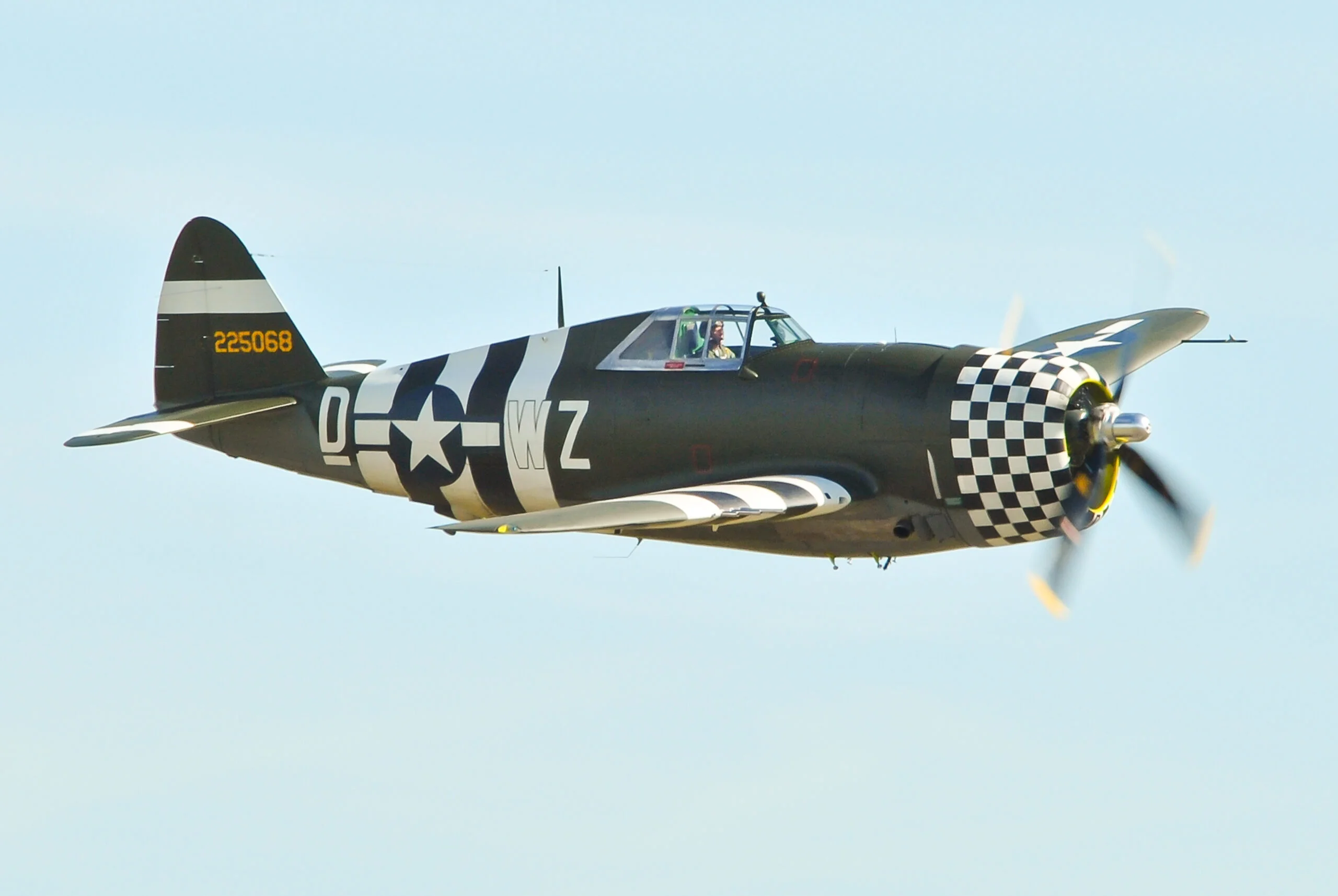
Republic P-47 Thunderbolt – The Jug
The P-47 Thunderbolt was one of the most famous combat aircraft of the Second World War, beloved by the pilots who operated it in the skies of Europe and the Pacific theatre and well respected by her opponents.
Initially conceived as a high-altitude fighter, the platform matured into one of the best fighter-bomber aircraft of the conflict, but also earned a reputation as a formidable and nimble air-to-air combatant.
The Thunderbolt spawned many aces, who made full use of the aircraft’s agility, firepower and amazing ability to absorb astonishing amounts of battle damage yet still return her pilots safely to base.
 The P-47 was a formidable ground attack aircraft thanks to the amount of firepower it could carry.
The P-47 was a formidable ground attack aircraft thanks to the amount of firepower it could carry.
The P-47 ended the conflict with a sterling reputation as an air combat fighter with an impressive kill-loss ratio and as one of the finest ground-attack aircraft of the European theatre.
Design and Development
The Thunderbolt design was commissioned to replace the first all-metal monoplane fighter in USAAC service, the P-35. The P-47 was designed by Alexander Kartveli, who like his fellow Georgian Peter Seversky (the designer of the P-35) had fled his homeland after the Bolshevik takeover in 1917.
Read More: C-5 Galaxy – The Big Daddy
The original concept for the Thunderbolt saw a sleek cowling encompassing the liquid-cooled in-line Allison engine, and this was the initial configuration approved by the USAAC as the XP-47.
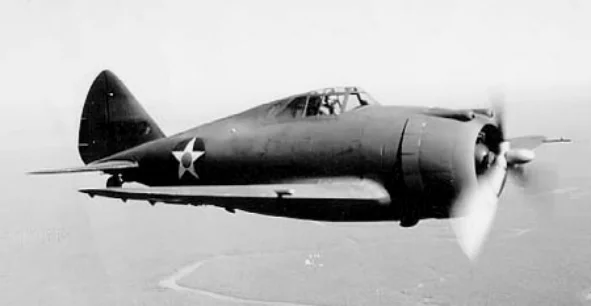 The forerunner to the Jug was the P-43 Lancer and design similarities can be seen.
The forerunner to the Jug was the P-43 Lancer and design similarities can be seen.
By 1940 the USAAC and the manufacturer Republic came to the conclusion that this design was inferior to Luftwaffe fighters, and Kartveli designed a much heavier and larger fighter which was offered to the government in June 1940.
This new design was approved as the XP-47B, and a prototype flew on the 6th of May 1941.
Despite some minor teething problems, the first series of test flights produced some impressive performance figures, including a top speed of 412 mph in level flight.
But even with some unresolved issues with the design, the USAAC ordered 171 examples of the P-47B in December 1941.
Even while manufacturing P-47Bs for service in Europe, Republic was constantly working to improve the design of the Thunderbolt, and by the end of 1942, most of the issues raised by pilots of the ‘B’ model had been addressed.
These improvements led to the introduction of the P-47C, and the re-named USAAF placed an order for 602 examples of this mark in September 1942.
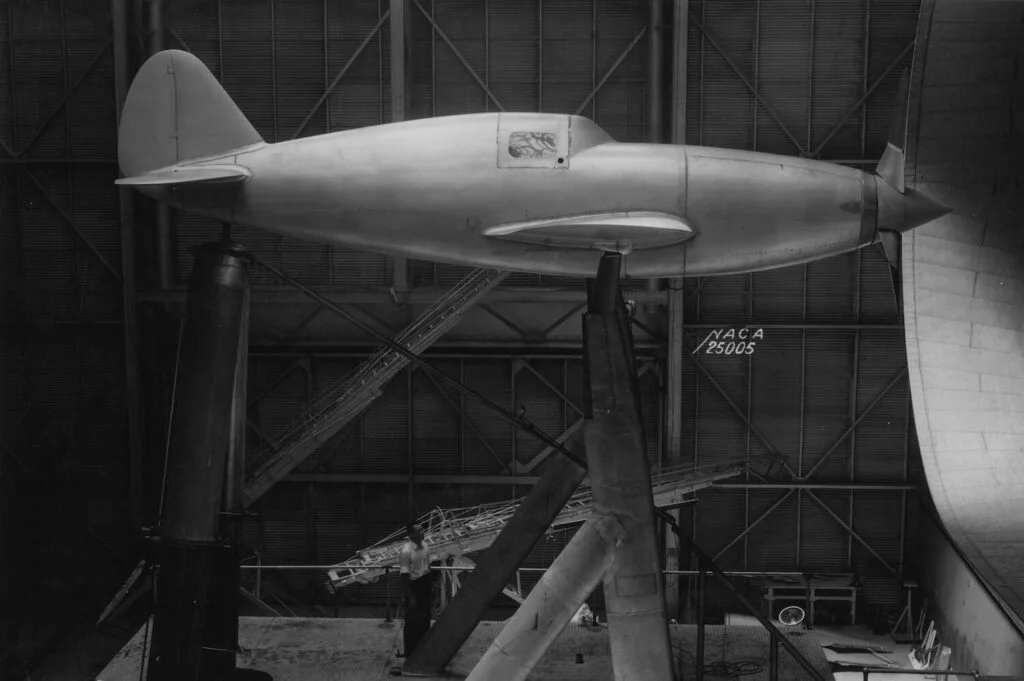 An XP-47 model during wind tunnel testing. This looked quite different from the production model.
An XP-47 model during wind tunnel testing. This looked quite different from the production model.
Initial deliveries of the P-47C were sent to the 56th Fighter Group, and this formation was sent to England as part of the 8th Air Force in January 1943.
Two further fighter groups already resident in England also converted to the P-47C, and the type commenced its first operational flights soon after.
Initially disparaged by their compatriots in the RAF, the Thunderbolt pilots gradually learned how to fight their new platform in the skies above Europe, and while weaknesses in the design still had to be worked out, the P-47C won a large measure of respect for her many sterling qualities in air combat.
The experience gained by pilots of the P-47C led to suggestions for further improvement in the design of the Thunderbolt, and Republic incorporated all these improvements into a new model, which became known as the P-47D.
 A P-47D model with the ‘razorback’ canopy design before the introduction of the bubble canopy.
A P-47D model with the ‘razorback’ canopy design before the introduction of the bubble canopy.
This model was the penultimate design and most manufactured variant of the Thunderbolt, with 12,558 examples being produced.
The first production models of the ‘D’ model were manufactured in the ‘razorback’ configuration of the ‘C’ model, but later production runs of the P-47D introduced the famous ‘bubble’ canopy, an idea that the USAAF had copied from the RAF’s Typhoon fighter-bomber.
Read More: Blohm & Voss BV 138 – The Sea Dragon
The ‘D’ model also introduced a paddle-bladed propeller, which greatly improved the performance of the Thunderbolt, and transformed it into an agile and deadly air-to-air opponent.
Two further variants of the Thunderbolt were introduced before production of the type ceased in October 1945.
The first of these was the P-47M which started to appear in limited numbers in late 1944 and was originally designed as a high-performance interceptor to be used against the V-1 cruise missile.
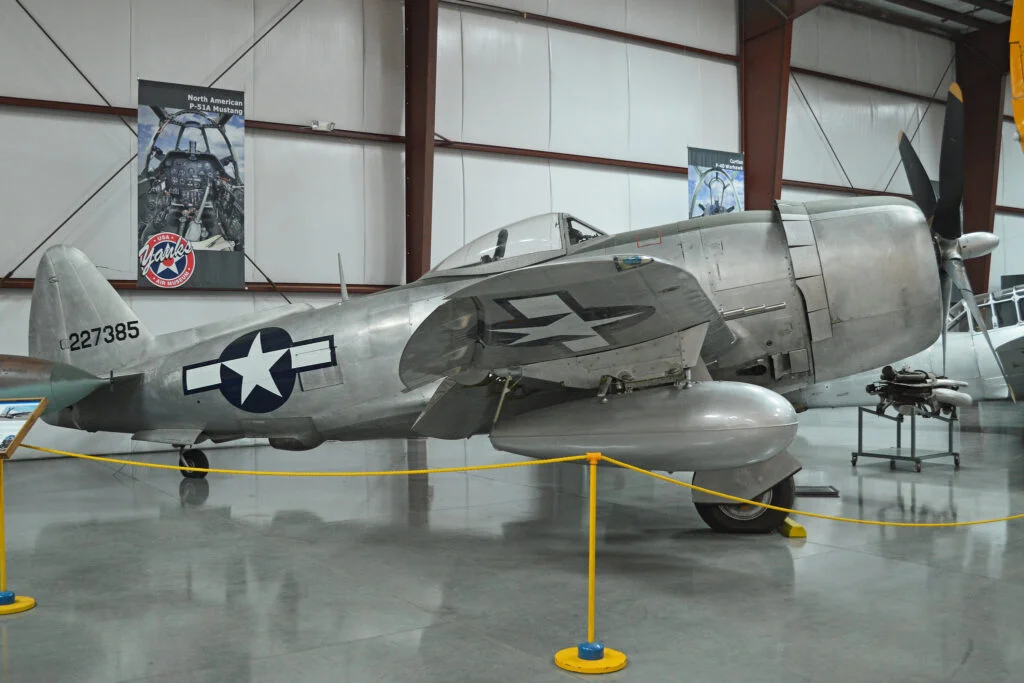 The P-47M was a formidable aircraft and was intended to engage V-1 flying bombs. Photo credit – Alan Wilson CC BY-SA 2.0.
The P-47M was a formidable aircraft and was intended to engage V-1 flying bombs. Photo credit – Alan Wilson CC BY-SA 2.0.
The entire production total of 130 aircraft was delivered to the 56th Fighter Group, but persistent problems with the high-power engine caused many operational sorties to be abandoned, and also resulted in crashes causing pilot fatalities.
By the time the power plant issues were rectified the air war in Europe had practically ceased, but the P-47M still claimed 12 aerial victories before the German surrender.
The last variant of the Thunderbolt was designed as a specialised high-altitude, long-range escort fighter for the B-29 Superfortress bomber, accompanying the B-29 on its raids over the Japanese mainlands.
With clipped wings to improve its roll rate, increased fuel capacity that gave a range of 2,000 miles (3,200 km), and power plant improvements which greatly increased its performance.
The P-47N sadly never made it into combat during World War 2, and instead served in many post-war air forces around the world. 1,816 examples of this model were manufactured before the cessation of Thunderbolt production in late 1945.
The Jug
The P-47 was one of the largest single-seat fighters of the Second World War, and her designer Kartveli commented: “It will be a dinosaur, but it will be a dinosaur with good proportions”.
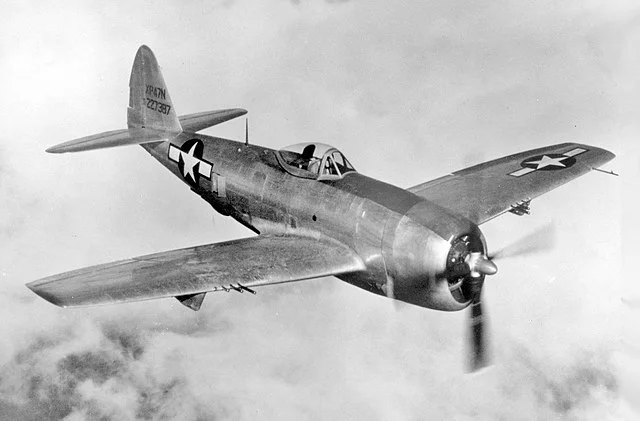 The P-47N never flew in combat during the Second World War. However it was significantly upgraded.
The P-47N never flew in combat during the Second World War. However it was significantly upgraded.
The massive size of the Thunderbolt was the result of being designed around the dimensions of the huge radial power plant, the Pratt & Whitney R2800 Double Wasp 18-cylinder radial engine, the same power plant choice for two other great American fighters, the Vought Corsair and the Grumman Hellcat.
This engine was constantly updated as later marks of the Thunderbolt were introduced, and the original 2,000hp of the P-47B had increased to 2,600hp in the P-47D and 2,800hp in the ‘M’ variant.
The dimensions of the P-47 were truly impressive for a single-seat fighter: a height of 14 feet (4.5 metres), a length of 36 feet (11 metres) and a wingspan of 40 feet (12.5 metres).
Empty, the Thunderbolt weighed in at 10,000 lbs (4,530 kg), and fully loaded tipped the scales at 12,700 lbs (5,770 kg). MTOW was 17,500 lbs (7,990 kg). Even an empty P-47 was more than twice the weight of a Spitfire.
 Often the P-47 would be seen with fuel tanks to further increase the already large range.
Often the P-47 would be seen with fuel tanks to further increase the already large range.
The combat range for the P-47C and D models was 800 miles (1,300 km), but this was improved with the widespread use of disposable drop tanks with extra fuel, allowing these marks to provide medium-range escort missions for the bombers of the 8th Air Force.
Read More: Messerschmitt P.1101- German Forefather of the Swing Wing
The USAAF gradually converted its fighter squadrons in England to the longer-ranged P-51 Mustang, which performed the majority of long-range escort missions.
Engine improvements over the production run of the Thunderbolt saw the speed of the aircraft increase with each new model release.
The ‘D’ had a top speed of 435 mph (700km/h) in level flight at 20,000 feet (8,000 metres), P-47M (the fastest variant) topped out at 475 mph, and the last ‘N’ model was capable of a top speed of 467 mph.
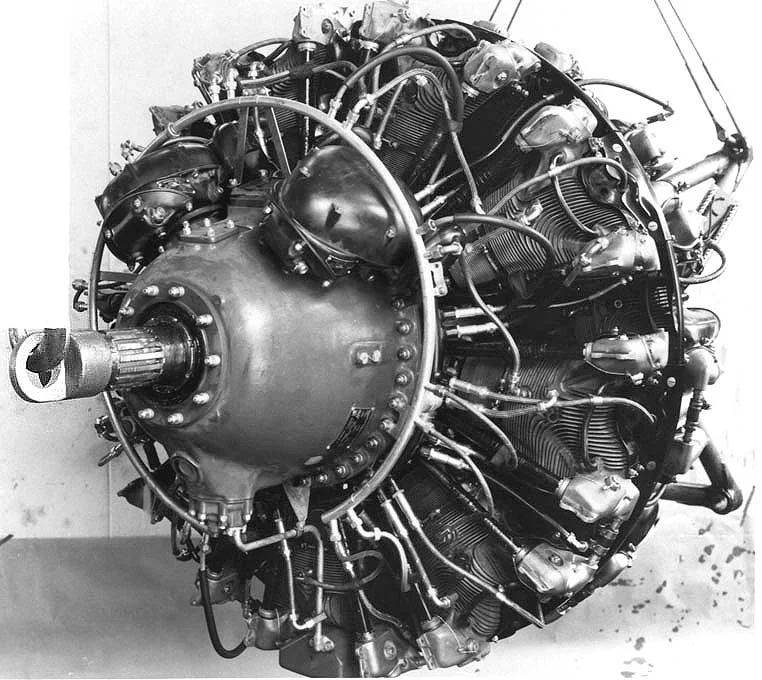 The Pratt & Whitney R-2800 was the heart of the P-47 and produced huge amounts of power.
The Pratt & Whitney R-2800 was the heart of the P-47 and produced huge amounts of power.
The P-47 was one of the most heavily armed single-seat aircraft of the Second World War, with eight Browning M2 .50 calibre (12.7 mm) machine guns mounted in a staggered configuration in the wings.
350 rounds were provided for each gun, and when all eight were firing the aircraft could deliver 100 rounds a second on target, explaining much of the devastation that occurred when the Thunderbolt was strafing ground targets and the ease with which it knocked down its aerial opponents in air-to-air combat.
The Thunderbolt was a superlative ground-attack fighter, capable of carrying an impressive amount of ordnance to strike ground targets.
Up to 2,500 lbs (1,000 kg) of bombs could be mounted on the wings, and ten 127mm (5 inches) rockets could also be carried on ground-attack sorties.
Later models had the necessary plumbing installed to allow the mounting of disposable wing fuel tanks, greatly increasing the range of the P-47 when used on escort or long-range missions.
 Republic P-47D-40-RE in flight firing rockets.
Republic P-47D-40-RE in flight firing rockets.
Service History
Despite some initial misgivings (and pointed barbs from Allied pilots flying other fighters), the pilots of the 56th FG grew to love their massive steeds, and this group operated the P-47 for the entirety of the war, refusing to convert to the P-51 Mustang when offered.
One great advantage quickly noticed was the ability of the Thunderbolt to dive out of trouble, and no Axis fighters were able to catch up when the P-47 was heading for the deck.
Helped by the weight of the massive engines, some insane speeds were recorded in dives, but many pilots’ claims that they had approached or even exceeded the speed of sound in dives were later proved to be the result of faulty instrumentation, and malfunctioning pitot tubes.
Jibes from some P-47 pilots that: “a good thing that it can dive, because it sure can’t climb” were silenced with the introduction of the P-47D with its engine improvements and paddle-bladed propeller, which greatly increased the performance and agility of the Thunderbolt.
 The later P-47D with the bubble canopy. Photo credit – Tim Felce CC BY-SA 2.0.
The later P-47D with the bubble canopy. Photo credit – Tim Felce CC BY-SA 2.0.
This model increasingly became the bugbear of the FW 190, which had found the ‘B’ and ‘C’ marks easier to deal with, but the introduction of the bubble-topped P-47D meant that the playing field was much more even, and Thunderbolt pilots started racking up some impressive aerial scores.
Many top-scoring aces flew the P-47, such as ‘Gabby’ Gabreski, Robert S. Johnson and Hubert Zemke. The P-47 ended the war with an impressive kill-loss ratio of 4.6/1.
The P-47 C started its service career as an escort fighter for the 8th Air Force and RAF bomber fleets, but its operational range at the time led it to be used only on medium-range missions.
The adoption of drop tanks and the increased range of the ‘D’ model saw its capability in escort work improve, but the widespread introduction of the long-range P-51 saw the Mustang assigned on most escort missions, and the Thunderbolt increasingly morphed into a formidable fighter-bomber.
 The P-51 was more often assigned to escort missions. Leaving the P-47 to become a deadly fighter/bomber.
The P-51 was more often assigned to escort missions. Leaving the P-47 to become a deadly fighter/bomber.
The formation of the Tactical Air Force before the Normandy landings, with its massed squadrons of RAF Typhoons and USAAF Thunderbolts was one of the best Allied tactical innovations of the war.
With both types of aircraft excelling in ground attack, German ground forces were only able to manoeuvre at night, and any German vehicle unlucky to be observed at any time was instantly attacked with rockets and bombs.
Rommel, who had experienced Allied air attacks in Africa repeatedly warned of the efficacy of Allied fighter-bombers and urged armoured formations to be stationed on the coast to escape the aerial attack, instead of being positioned further inland.
He was not listened to, and when German reinforcements attempted to advance to the Normandy area, they were subjected to merciless air attack, which greatly slowed their advance, and caused much material and personnel losses.
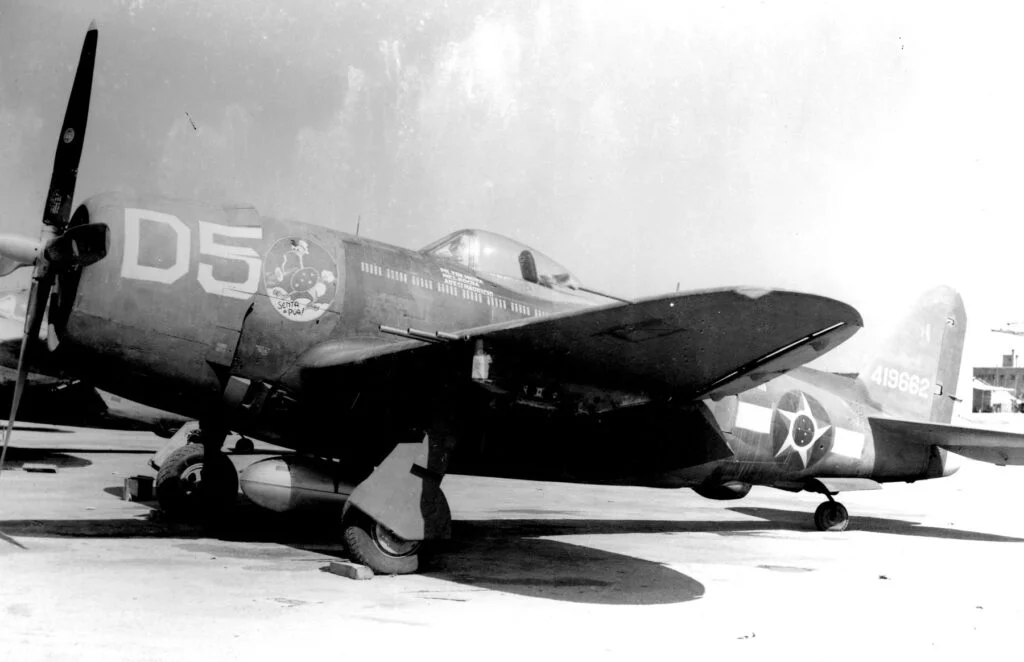 1º GAC P-47s carried additional nose art alongside the insignia of Brazil.
1º GAC P-47s carried additional nose art alongside the insignia of Brazil.
The P-47 was often the star of these ground attacks, and the ruggedness of the airframe meant that many shot-up Thunderbolts managed to return safely to base after battle damage that would have downed any other aircraft.
The British also employed the P-47 in the ground-attack role in the Pacific Theatre. In Burma, P-47s of the RAF performed sterling duty in the ground-attack role, with the Allies using the lighter Spitfire for fighter cover, allowing the Thunderbolt pilots to concentrate on ground targets.
Read More: Focke-Wulf Ta 152 – FW 190 But Better?
The P-47 Thunderbolt was one of the premiere air-combat aircraft of the Second World War, and also had an impressive record as a ground-attack fighter.
Easily the best of the early USAAC/USAAF fighters, performance improvements meant that it stayed in the front line of aerial combat until the end of the war.
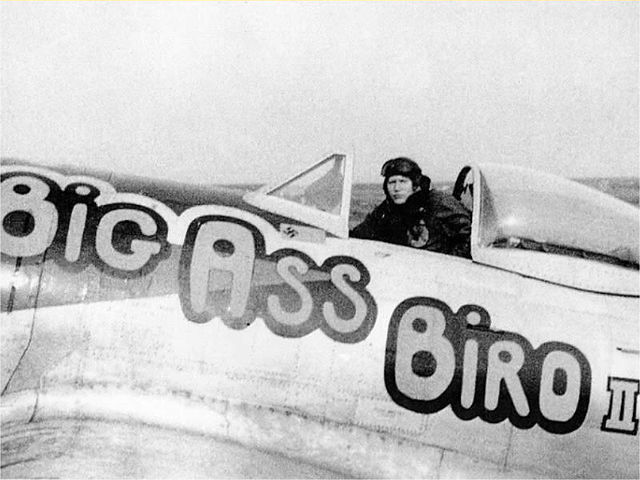 The P-47 had some affectionate nicknames…
The P-47 had some affectionate nicknames…
Even with the introduction of later Luftwaffe fighters, the Thunderbolt was able to hold its own and achieve aerial victories, including some jet fighters introduced by Germany late in the conflict.
It was loved by its pilots, dreaded by its enemies, and rightfully deserves a place in the pantheon of great combat aircraft of all time.
News
The Hanging Temple: China’s 1,500-Year-Old Cliffside Marvel of Faith and Engineering
The Hanging Temple: China’s 1,500-Year-Old Cliffside Marvel of Faith and Engineering Perched precariously on the cliffs of Mount Heng in Shanxi Province, China, the Hanging Temple, also known as Xuankong Temple, Hengshan Hanging Temple, or Hanging Monastery, is an architectural…
The Willendorf Venus: A 30,000-Year-Old Masterpiece Reveals Astonishing Secrets
The Willendorf Venus: A 30,000-Year-Old Masterpiece Reveals Astonishing Secrets The “Willendorf Venus” stands as one of the most revered archaeological treasures from the Upper Paleolithic era. Discovered in 1908 by scientist Johann Veran near Willendorf, Austria, this small yet profound…
Unveiling the Maya: Hallucinogens and Rituals Beneath the Yucatán Ball Courts
Unveiling the Maya: Hallucinogens and Rituals Beneath the Yucatán Ball Courts New archaeological research has uncovered intriguing insights into the ritual practices of the ancient Maya civilization. The focus of this study is a ceremonial offering found beneath the sediment…
Uncovering the Oldest Agricultural Machine: The Threshing Sledge’s Neolithic Origins
Uncovering the Oldest Agricultural Machine: The Threshing Sledge’s Neolithic Origins The history of agricultural innovation is a fascinating journey that spans thousands of years, and one of the earliest known agricultural machines is the threshing sledge. Recently, a groundbreaking study…
Nara’s Ancient Sword: A 1,600-Year-Old Protector Against Evil Spirits
Nara’s Ancient Sword: A 1,600-Year-Old Protector Against Evil Spirits In a remarkable discovery that has captured the attention of archaeologists and historians alike, a 7.5-foot-long iron sword was unearthed from a 1,600-year-old burial mound in Nara, Japan. This oversized weapon,…
The Inflatable Plane, Dropped Behind the Lines for Downed Pilots
Experimental The Inflatable Plane, Dropped Behind the Lines for Downed Pilots The Inflatoplane from Goodyear was an unconventional aircraft developed by the Goodyear Aircraft Company, a branch of the renowned Goodyear Tire and Rubber Company, also famed for the Goodyear…
End of content
No more pages to load











